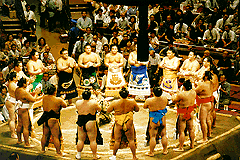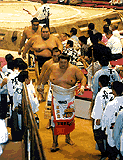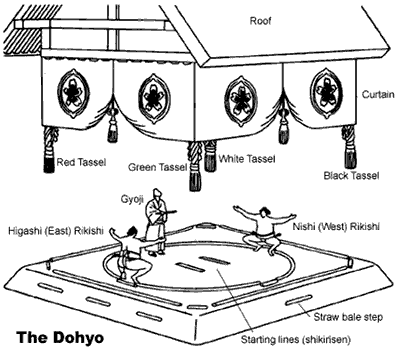Sumo - Traditional Japanese Wrestling
Sumo: Introduction | The Basics | The Basho | The Hanada Dynasty
The Basics
Sumo dates back 2,000 years but only became a professional sport in the early Edo Period (1600~1868). It is also practised at community level in some rural areas and in universities. Although some successful university rikishi go on to professional sumo, usually they lag behind those who entered a professional heya (stable, literally 'room') in their mid-teens. All unmarried maezumo (apprentices) and rikishi (wrestlers) must live in their heya under the supervision of their oyakata (stablemaster) and his wife, called the okamisan. They live very much according to their rank, with the juniors having to share rooms, get up and train earlier, perform all the household chores and eat their traditional sumo meal of chanko-nabe stew after the others have finished. The established heya are run by oyakata who were top rikishi in their own day.

Makunouchi dohyoiri - during...

...and after
There are six divisions (see The Basho for details of the ranking system) - four junior divisions who fight on only 7 of the 15 days of the basho (tournament) and two upper divisions, whose rikishi earn the name sekitori, receive a salary from the Sumo Association and who fight on each of the 15 days. Rikishi move up - or down - through the ranks based only on their basho performance. In this sense, seniority is no guarantee of high rank. In each of the junior divisions and in the sekitori ranks the primary aim is the yusho or championship. The yusho race usually boils down to the yokozuna (grand champions), sanyaku (three ranks of champions) and the odd dark horse. If the yusho is out of their grasp, the aim is to have at least a kachikoshi or 8-7 majority of wins to ensure promotion for the next basho. A makekoshi losing record will ensure demotion, possibly to a lower division on the banzuke, a list of all the rikishi and their ranking for the basho. The only rikishi who cannot be demoted are the yokozuna. However, if they can't keep up the high standards of their rank, they are expected to retire.
Sekitori wear a colored silk mawashi (belt) in basho, whereas a beige mawashi is used in training or by junior rikishi. It is wrapped around the waist and groin and knotted at the back. There is also a sagari or silk string apron tucked into the front of the mawashi. The sekitori wear colorful kesho-mawashi during dohyo-iri (ring-entering) ceremonies. Also, only sekitori can have their long hair oiled and tied in an oichomage (top knot).

There are two main styles of sumo - tsuppari or thrusting and yotsu-zumo, which involves trying to control the opponent with the help of a grip on his mawashi. Rikishi usually favor one style but sometimes develop the ability to use both. Hawaiian-born Yokozuna Musashimaru, for example, had a remarkable record of consecutive kachikoshi basho (52 as of the Kyushu basho, 1999) using the tsuppari attack but seemed stuck at the second-highest ozeki rank. After he developed more of a yotsu-zumo style he became stronger still and gained promotion to yokozuna in May 1999. There are officially 70 winning techniques but only about a dozen or so are commonly seen. The most common include yorikiri (force out), tsuridashi (lift out), uwatenage (outside grip arm throw) and tsukidashi (thrust out). Some of the smaller rikishi, such as Wakanohana and Mainoumi in recent years, have to develop a serious repertoire of techniques to make up for their lack of size.
The salaries that sekitori receive from the Sumo Association obviously increase with rank. The monthly salary+allowance figures below date from March 2001:
- Yokozuna: ¥2,820,000
- Ozeki: ¥2,350,000
- Sanyaku: ¥1,700,000
- Maegashira: ¥1,300,000
- Juryo: ¥1,030,000
A yusho brings with it prize money varying from ¥100,000 at the lower ranks to ¥10 million for a makuuchi championship. There are also prizes awarded for such things as technique and fighting spirit at the end of a basho. Sekitori also receive half of the prize money offered by sponsors of certain bouts (¥60,000 per sponsor) if they win. They also usually have a support group of fans, private and corporate, who are very generous with gifts such as their expensive silk kesho-mawashi. Also, the heya provide food and accomodation for the many single rikishi who live there.
Related topics:
